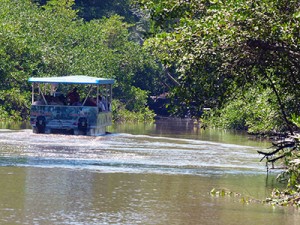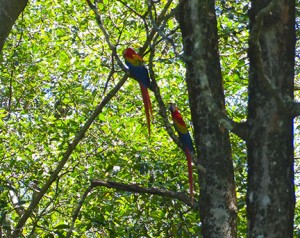 By Rick Millikan
By Rick Millikan
“Welcome to Costa Rica!” our guide Miguel grins. “The name of our port and province is Punta Arenas, which means point of sand. On today’s excursion, we’ll leave this peninsula’s great beaches behind and investigate Punta Arena’s spectacular nature.”
Travelling southward, our bus passes through mixed deciduous forests covering the coastal mountains. Pointing out two small wood mills, Miguel lists his country’s familiar and unfamiliar hardwoods: mahogany, teak, Spanish cedar, cocobolo, cedro macho and sura.
Back toward the coast, forests soon disappear. “Farmers cleared many of Costa Rica’s forests during the 60’s,” Miguel explains. “Trees are more valued now and today, farmers are compensated for leaving trees.”
A few Brahma cattle, goats and horses graze in numerous pastures surrounded by ‘living fences.’ “These thick green barriers result from planting branches as posts. They take root and grow into green hedges fences,” he explains. “These farmers cultivate many interesting crops,” he remarks, passing around samples of local plants. We examine the ear tree’s lobed pods, red cashew fruit, two-foot beans, noni and calabash gourds for making maracas.
Descending back to the lowlands, our bus proceeds along a lengthy sandy shore and into a fenced park-like setting. Hopping off the bus, our group boards a canopied float-boat. Beside the dock, a night crane ignores us as it slowly wades, focused on catching a meal.
Our exploration of this coastal estuary begins by chugging alongside spidery-rooted mangroves lining the channel. “These mangroves protect the land and provide shelter for animals,” the captain says, “Like that alligator on the muddy bank.” Shipmates snap photos. A few grumble about its small size. Recalling news items reporting large alligators attacking people, we prefer these medium sized reptiles.
 He then points out several green iguanas. “A delicacy, locals love to eat these now endangered reptiles. Hunting these ‘chicken of the trees’ is forbidden,” he smiles. “Hungry? Nowadays, farmers are allowed to raise them for food!”
He then points out several green iguanas. “A delicacy, locals love to eat these now endangered reptiles. Hunting these ‘chicken of the trees’ is forbidden,” he smiles. “Hungry? Nowadays, farmers are allowed to raise them for food!”
Wildlife abounds along the waterway. Howler monkeys yowl at our approach. In the thick foliage of lofty trees, we sight them ripping off leaves to eat. Macaws squawk shrilly in a grove of hardwood trees. Flashing red, white, yellow and blue feathers, one pair of Scarlet Macaws cavorts among the high branches. One straddles a branch upside down. These big colorful birds mate for life, living up to fifty years in the wild. Coastal palm trees offer them rich nut diets.
Returning dockside, we spot large brown termite nests clustered in several trees. These provide meals for anteaters. Nearby, a basilisk lizard perches on an irrigation pipe. Also known as Jesus Christ lizards, they famously walk on water.
As the jungle safari ends, our hosts invite us to enjoy slices of cold melon, pineapple and icy Imperial beer. Under shady palapas, we rehydrate and relax. Costa Ricans are noted for their hospitality.
Heading next to a small train station, we board an old passenger train. The engine chugs up through the mountainous countryside passing small ranches, melon farms, mango orchards and villages. This pleasant journey reveals another perspective of Costa Rica.
“Costa Rica’s mountainous terrain once presented a transportation nightmare,” Miguel notes. “Granting land to United Fruit Company to build rail lines for marketing Caribbean bananas, the government couldn’t find support for Pacific coast railroads…so ox carts carried our coffee and other products for decades. Eventually, trains like this and better roads enabled the agriculture seen today.”
Costa Rica proves full of life, offering diverse wildlife and a cornucopia of products. Next time, we hope to explore one of Costa Rica’s national parks. These parks encompass 25% of Costa Rican land preserving its rich natural environment.